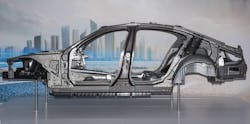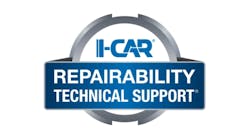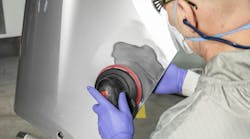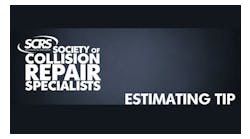Challenges and Solutions in Repairing Advanced Automotive Materials
Some 20 years ago, collision industry leaders raised alarm bells around the critical safety issues posed by structural parts composed of new high-strength steels (HSS). These parts were difficult to cut while at the same time susceptible to damage from the heat released by welding, and that damage could easily prevent complex safety systems from operating correctly. Complicating this matter further, at the time, many - maybe most - shops were oblivious to the problem, since they didn’t regularly turn to OEM repair steps and relied instead on previous experience and outdated training. Just when it seemed this situation couldn’t get any worse, many OEMs didn’t provide accurate mapping of these parts and lagged when it came to providing updated repairs – leaving shops to create their own lists of HSS parts and acceptable, safe repairs.
Fortunately, over time, OEMs began providing up-to-date repair steps and info, and many shops invested in the training and equipment to perform these repairs. Thus, tragedy was averted. The repair industry passed over the hump of new automotive design technology, or did it?
OEMs and repairers became adept at addressing HSS parts, but these were followed by UHSS, and then new generations of HSS and UHSS parts, followed by alternative materials and then parts composed of a number of different advanced materials.
That’s where the automotive industry is today – churning out new vehicles with parts constructed of a range of materials intended to provide lower vehicle weights (and thus better fuel efficiency), paired to a stronger, safer auto body. The repair industry has worked long and hard to ensure the safe repair/replacement of these parts. Due to the increasingly complex nature of vehicle parts and their repair, the question remains even now: Are you as prepared and capable as you should be to do this work?
Refer to the following five tips supplied by I-CAR experts Anton Verwijst and John Hartford to guide your work on the latest mixed material auto parts.
Tip 1: Become familiar with the parts that provide that most significant repair challenges.
Focusing on your biggest challenges helps ensure you keep materials issues in mind all the time. I-CAR notes the following examples, beginning with sectioning procedures on vehicles featuring carbon-lined structural components, like 2016 BMW 7-series models.
This sedan features carbon rod reinforcements in the roof rails, carbon-lined B-posts, carbon-reinforced rocker panels and linings in various other places. There also is a small carbon core badge at the top of the B-pillar you can see when opening one of the doors. The challenge lies in identifying this use of the material and then performing any section there and nearby. As always, being certain to always check the OEM repair steps is the best way to address these challenges, along with having the necessary training.
Another notable difficulty is the removal of boron structural parts, especially in several repair scenarios. These boron parts are not repairable but are often changed during repairs. Boron is extremely difficult to drill or cut through, even in the welds. This is because the steel on a boron part is harder than any drill bit available. Even though the welds may be drilled, the cost for the necessary bits is extremely high. Further, the bits are “consumables,” since one usually only lasts for a few spot welds - meaning it takes several bits to remove just one part.
Drilling can be replaced by employing a grinding stone or a hand-held belt sander with 36 grit belts, but these also end up being consumables. However, when used carefully, this combination will allow you to remove the weld without removing material from the panel behind it.
Tip 2: Keep abreast of the newest advanced materials and the latest generations of existing ones coming to market.
Advanced materials such as carbon fiber-reinforced plastics and 3-D printed plastic parts are enabling remarkable improvements in safety, design and performance and are opening the door on what looks to be a whole new era in vehicle manufacturing, sustainability and repairs. In 2019, BMW produced more than 300,000 3-D-printed parts in their BMW, Mini and Rolls-Royce vehicle lines.
I-CAR says there is more aluminum, magnesium, and carbon fiber-reinforced plastics (CFRP) for structural parts and more plastics/composites in automotive vehicle construction than ever before... much more. Low and ultra-low-Density Sheet Molding Compounds (SMC) are also being used. In most cases these types of parts are replaced, not repaired.
Automakers additionally are using composites for all types of auto parts, including energy absorbers, interior panels, rear hatch panels, deck lids, roof panels and bumpers. Note that the repair of these parts is limited to very minor repairs.
A new alternative material is CNFs (cellulose nano fibers). This composite material is made of wood fibers from recycled agricultural waste and is five times stronger than a conventional steel panel, with only one fifth the weight. The CNFs (cellulose nano fibers) are combined with polypropylene (PP), polycarbonate (PC), nylon 6 (PA6) and epoxy resin to construct auto body parts and panels. Amplitex is a composite made of layers of reinforced fabrics. It can be compression-molded to form auto interior panels. This composite can match the performance of carbon fiber parts but with a smaller CO2 footprint.
Additive technology for manufacturing care part also continues to grow in usage among OEMs. SMARTech reports that the current leader in using additive technology is Volkswagen, with the second position occupied by BMW and Ford. Aluminum, not necessarily new to the auto market, similarly continues to expand in usage to reduce unwanted vehicle weight. Vehicle makers that used lesser amounts of aluminum in the past have started using much more in the past few years, changing the way vehicles are both built and repaired.
One growing aluminum trend I-CAR recommends keeping an eye on is the construction of strut tower assembly replacement. At the factory, the steel apron is riveted and bonded to the cast aluminum strut tower. In other cases, this structural part is constructed with the strut tower bonded and riveted to the upper fender support.
To avoid cross-contamination or galvanic corrosion, extreme caution must be used when attaching aluminum or mixed material parts to a steel part. Adhesives must be applied liberally to these areas to not only ensure proper adhesion but to also protect the surface agents from corrosion. The new assembly should never be separated where the factory has attached the two mixed material parts together.
I-CAR stresses checking OEM procedures before attaching any structural parts since there always is the possibility that the replacement part must be attached differently than it was at the factory.
Tip 3: Invest in the latest OEM-required tools.
I-CAR says these tools include, but are not limited to, special rivet guns for removal and fastening of self-piercing or other types of rivets, welding equipment, vacuum and extraction systems, along with separate hand and power tools. These required tools help assure the prevention of galvanic corrosion and cross-contamination. Some automakers, such as Porsche and BMW, require an SPR rivet extractor that welds a stud onto the rivet, which is then used by the rivet gun to extract the SPR.
Shops further must possess equipment that can weld steel, aluminum and bronze (MIG brazing). In addition to specific welding equipment, vehicle makers may require a frame bench with specific vehicle fixtures and a three-dimensional electronic measuring system for diagnostic and structural repairs.
Tip 4: Address any and all concerns you may have when performing repairs on mixed material parts.
Never simply guess. Seek out the right answers. Training and reaching out to experts are key here.
I-CAR experts say the most common question they encounter while working on mixed material vehicles is whether any anchoring or pulling should be performed. As trained aluminum/mixed material structural technicians, their response is “absolutely not.”
They note that today’s vehicles are bonded together, and if you make pulls on them, you run the risk of breaking a bond. If carbon fiber or similar mixed materials are involved, the risk of causing irreversible damage to the structure is raised even higher. Should this occur, the vehicle may end up with a squeak or rattle somewhere in the structure that may never be found, along with safety issues that compromise the vehicle’s internal strength and integrity.
I-CAR declares that you must always both reference the vehicle maker service information and ensure you have the proper training and knowledge necessary before performing any repairs. They note these vehicles still require structural repair equipment since they may need to be placed in fixtures when some structural parts are replaced to ensure dimensional accuracy.
Moreover, I-CAR strongly recommends every shop be completely clear about what types of materials they are working with at all times. Adhesives are specific to each automaker, as well as rivets. In some cases, welding is required, while in others bonding and riveting is necessary. Furthermore, they say that when you are replacing a structural component, you need to wait until you have the new assembly in front of you before starting the repair - just to make sure you know exactly what you are dealing with.
More on this subject: How I-CAR's Advanced Training Can Help Technicians Repair Lightweight Materials Correctly
Tip 5: Invest in as much training as possible.
Advanced training can be obtained from I-CAR along with vehicle-specific manufacturer training to ensure technicians develop the knowledge and skills to determine how to make complete, safe and quality repairs. I-CAR says techs also should be trained to more effectively navigate through the manufacturer's website and service procedures since it can be exceedingly difficult to find the right information (each manufacturer may have slight differences in its repair procedures).
I-CAR further states that technicians need to obtain certification from the vehicle maker or welding training and certification through I-CAR to create welders who are proficient in steel aluminum, and bronze welding.
Additional training on a three-dimensional measuring system and/or dedicated frame bench is critical as well. Proper training and skills are necessary for making decisions on whether a part is to be repaired or replaced to maintain vehicle safety, strength and integrity. The goal is always to do whatever is necessary to ensure a repaired vehicle will respond as designed in another collision, with the smallest amount of intrusion into the vehicle as possible.
That direction pretty much sums up the goal of properly addressing mixed material parts and construction – as it does with handling traditional materials and construction. Whatever the case may be, techs must always be aware of the type of materials used in every vehicle they repair. Research and knowledge are more important than ever. If proper procedures are not followed, a technician can do more harm than good, causing irreversible damage to the vehicle and potentially mortal harm to vehicle occupants. All that can be avoided with the necessary focus on regular education and training and the correct investment in the right tools – all things you already should be doing every day.








